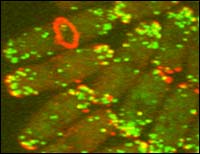Yale researchers make cell biology quantitative

Yeast cells with tagged Cdc15p (red) and fimbrin (green) proteins show a contractile ring and actin patches. Credit Jian-Qiu Wu
Yale researchers have reported a method to count the absolute number of individual protein molecules inside a living cell, and to measure accurately where they are located, two basic hurdles for studying biology quantitatively.
“The method makes possible accurate measurements of proteins inside cells using microscopic methods usually used just to show where proteins are located,” said senior author Thomas D. Pollard, M.D., Chair and Higgins Professor of Molecular, Cellular & Developmental Biology at Yale, of the work published in Science.
Postdoctoral fellow Jian-Qiu Wu attached a tag called yellow fluorescent protein to proteins of interest, allowing these proteins to be detected in live yeast cells with a light microscope. He used seven sample proteins to demonstrate that the brightness of the fluorescence is directly correlated with the amount of that protein in the cell.
With this reference, they could take a stack of pictures through any whole cell that makes a tagged protein, count up all the fluorescent signal, and calculate the number of molecules by comparing with their standardized sample proteins. The assay works whether the molecules are spread out or concentrated in particular parts of the cell, so they could also count the number of molecules in different locations throughout the cell.
Wu assayed the overall and local concentrations of more than two-dozen proteins. Some regulatory proteins had only a few hundred copies, while the common protein actin had millions of copies. The measurements revealed for the first time the ratios of proteins making up structures such as the “contractile ring” that pinches cells apart as they divide.
“People working on yeast should be able to use this method straight out,” said Pollard. “Tagging proteins by manipulating their genes is a bit more complicated in other organisms, but it can be done with some work — even in human or plant cells.”
“It is surprising that no one has made this calibration before. Biology has tended to be descriptive,” said Pollard. “This technology is part of moving biology to be more quantitative and mechanistic. You can’t understand the chemistry and physics of cells without knowing the concentrations of the proteins.”
Media Contact
More Information:
http://www.yale.eduAll latest news from the category: Life Sciences and Chemistry
Articles and reports from the Life Sciences and chemistry area deal with applied and basic research into modern biology, chemistry and human medicine.
Valuable information can be found on a range of life sciences fields including bacteriology, biochemistry, bionics, bioinformatics, biophysics, biotechnology, genetics, geobotany, human biology, marine biology, microbiology, molecular biology, cellular biology, zoology, bioinorganic chemistry, microchemistry and environmental chemistry.
Newest articles

Sea slugs inspire highly stretchable biomedical sensor
USC Viterbi School of Engineering researcher Hangbo Zhao presents findings on highly stretchable and customizable microneedles for application in fields including neuroscience, tissue engineering, and wearable bioelectronics. The revolution in…

Twisting and binding matter waves with photons in a cavity
Precisely measuring the energy states of individual atoms has been a historical challenge for physicists due to atomic recoil. When an atom interacts with a photon, the atom “recoils” in…

Nanotubes, nanoparticles, and antibodies detect tiny amounts of fentanyl
New sensor is six orders of magnitude more sensitive than the next best thing. A research team at Pitt led by Alexander Star, a chemistry professor in the Kenneth P. Dietrich…





















